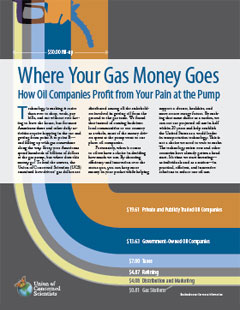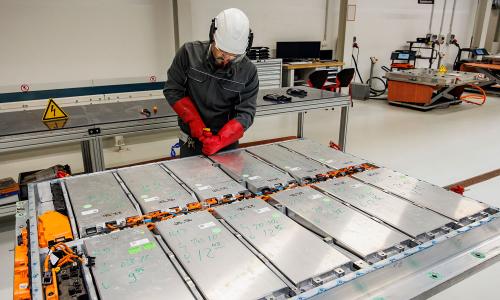Every year we spend hundreds of billions of dollars at the gas pump, but where does that money go? To find the answer, UCS examined how drivers' gas dollars are distributed among all the stakeholders involved in getting oil from the ground to your gas tank.
The results are clear. Your gas money doesn't support your local gas station, nor does it benefit you financially, even if you own oil company stock. Most of the money you spend at the pump goes directly to one place: oil companies.
You have a choice when it comes to your oil use: Continue pumping your money into oil company profits or invest in fuel efficiency and keep the profits in your pocket instead.
We spend a lot of money on gas
- Vehicle owners, on average, spend almost as much on gas as on the vehicle itself.
- A typical US driver will spend more than $22,000 on gas over the lifetime of a vehicle purchased in 2011 with average fuel efficiency (22.8 mpg).
Most of your gas money goes directly to oil companies
- Out of the more than $22,000 spent on gas over the lifetime of an average vehicle bought in 2011, oil companies rake in about $15,000.
- Of the remainder, 14 percent of the money spent on gasoline goes to taxes that help pay for roads and transportation services, 10 percent to refining costs, and 8 percent to distribution and marketing.
- Gas stations average only three to five cents of profit from each gallon of gasoline sold. They make more profit off the bottled water and candy you buy inside than off the fuel you buy outside.
You gain virtually nothing in return—even if you own stock in oil companies
- Regardless of how many shares you may own in oil companies, your oil use does not benefit your bottom line.
- Say you have $20,000 invested in ExxonMobil, the largest publicly traded oil company in the world. If you spent $1,700 on gas from ExxonMobil over the course of a year, your fuel purchase would yield far less than a penny in stock earnings. Even if you had $1 million invested, you would still get less than one cent in return after spending almost $2,000 on gasoline.
Investing in fuel efficiency always pays dividends
- Rather than getting pennies in return for what you spend at the pump, you can save thousands by investing in a fuel-efficient vehicle, and even more by investing in a hybrid vehicle, even after paying for the upfront cost of the hybrid technology.
- While you may pay $3,500 more for a fuel-efficient vehicle like a Ford Fusion SE Hybrid, you’ll save nearly $9,000 in fueling costs over its lifetime. Which would you prefer, a penny growth in your stock or thousands more in your pockets?
- By saving money at the pump, you will have more money to spend in other sectors of the economy — from education to construction — that have higher job growth potential compared with the oil and gas industry.
- Reducing our oil use is a smart strategy for our pocketbooks, our climate, and our health. Putting efficient technologies and innovative solutions to work, we can cut our projected oil use in half—saving more than 11 million barrels of oil every day by 2035. Learn more about the Half the Oil plan and discover what you can do to help reduce U.S. oil use.




